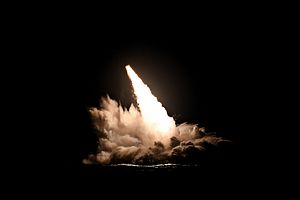Is the Trump administration interested in authorizing the development of a new nuclear warhead? The U.S. Department of Energy’s fiscal year 2021 budget request, revealed on Monday, outlines, among other things, a new warhead program known as the W93.
As part of the budget request highlights published by the National Nuclear Security Administration (NNSA), which is the U.S. Department of Energy agency charged with maintaining the U.S. nuclear arsenal, the “W93 warhead program” is identified alongside four other older programs as part of the weapons activities’ budget request. The total budget request for this category of NNSA activities for fiscal year 2021 is $15.6 billion, a 25.2 percent increase over the fiscal year 2020 amount.
The funds will “sustain and modernize the U.S. nuclear weapons stockpile with five weapons programs, including the B61-12 Life Extension Program, W80-4 Life Extension Program, W88 Alteration 370, W87-1 Modification Program, and the W93 warhead program,” the NNSA noted.
The NNSA’s budget release describe the W93 warhead program for the first time in its budget release in a single sentence: “The W93 warhead program was recently endorsed by the Nuclear Weapons Council and the Deputy Secretary of Defense to support the U.S. Strategic Command-required replacement for the Navy’s Trident II D5 submarine launched ballistic missile (SLBM).”
Analysts like the Federation of American Scientists’ Hans Kristensen (disclosure: I am affiliated with FAS) have pointed out that the W93 name, which is now public, is likely a new moniker for what was previously known as the Interoperable Warhead-2 and the “Next Navy Warhead” in the NNSA’s July 2019 Stockpile Stewardship and Management Plan (SSMP).
In the SSMP, the “Next Navy Warhead” was slated to enter the “studies and engineering” phase of development in fiscal year 2024. If the W93 is the same warhead that was envisioned previously, it will deploy on the U.S. Navy’s next-generation ballistic missile submarines, the Columbia-class, for the entirety of that platform’s lifetime.
What’s unclear for now is what kind of warhead the W93 will actually end up being. The United States has not designed any warheads from scratch since the W88, which is the highest-yield option on board the U.S. Navy’s currently operational Trident II D5 submarine-launched ballistic missiles. The development of the W88 was completed in 1989.
One concern with the W93 designation is that the designation itself suggests something grander than a modification, or “mod,” like the recently fielded W76-2, which is a primary-only, lower-yield derivative of the W76-1 warhead. Calling the new warhead the W93 may imply an all-new design.
As a corollary of developing a new design, calls to resume nuclear testing might resurface in the United States. The fiscal year 2021 budget is silent on this matter and the Trump administration has not officially suggested that any new warheads might need to be tested, but this would be a major concern.
The United States ceased nuclear testing and entered a self-imposed moratorium on September 23, 1992. The only country to have tested any nuclear weapons in the 21st century is North Korea, which has been heavily criticized by the United States and other countries for doing so.
The Trump administration published a Nuclear Posture Review in 2018 that called for two new nuclear capabilities. The first of these, the W76-2, has been developed and fielded by the U.S. Navy. The second was a sea-launched cruise missile, which has yet to enter production.
































